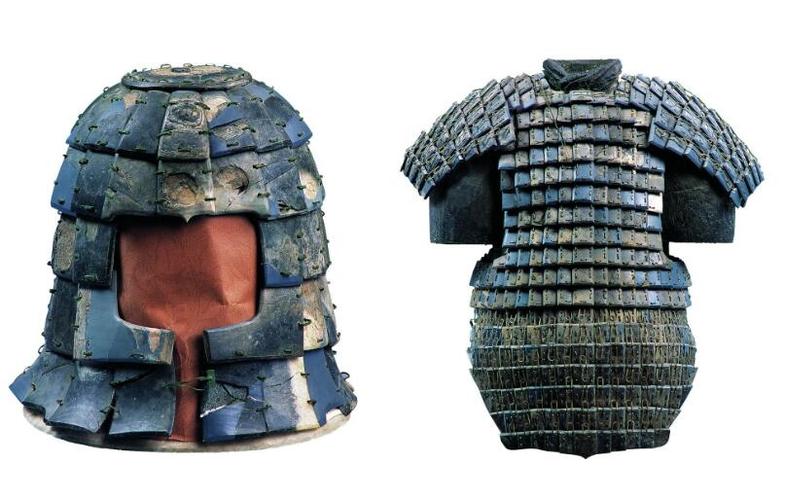
What Was the Terracotta Army's Armor Made Of?
The Terracotta Army is a collection of thousands of life-sized clay soldiers that were buried with the first emperor of China, Qin Shi Huang, in the 3rd century BCE. The army was meant to protect the emperor in the afterlife, and the soldiers are incredibly realistic, each with their own unique facial features, hairstyles, and armor.
Zhou & Qin Armour
The armor worn by the Terracotta Army is typical of the Warring States period (475–221 BCE) and the subsequent Qin dynasty (221–206 BCE). It is believed to have been crafted from a variety of materials, including:
Leather
Much of the armor was crafted from leather, likely tanned using plant-based tannins. This process would have involved soaking animal hides in water mixed with tannins, causing the proteins in the hide to bind together and become more resistant to decay and water damage.
After tanning, the leather would have been lacquered. Lacquer, derived from the sap of the lacquer tree, provided further protection against the elements, made the armor more rigid, and gave it a glossy finish. The lacquer was often applied in multiple layers, with each layer allowed to dry and harden before the next was applied. This process created a tough, waterproof, and visually striking armor.
Evidence suggests that different types of leather were used for different purposes. Thicker, tougher leather was used for things like breastplates and helmets, while thinner, more flexible leather may have been used for elements like sleeves or the lamellar sections of the armor.
Lamellar Construction
The Qin army favored lamellar armor, a type of armor made from small plates (lamellae) that were strung together. These lamellae were often made from leather, as described above, but other materials could have been used as well.
Each individual lamella was relatively small, often rectangular or triangular in shape. These lamellae were then drilled with holes, allowing them to be laced together with cord or leather throngs. This type of construction allowed for a great deal of flexibility, as the overlapping plates could move with the wearer.
Lamellar armor was highly effective for its time, offering protection from slashing and piercing attacks. It was also relatively light compared to other types of armor, such as mail or plate, making it ideal for soldiers who needed to be able to move quickly and easily on the battlefield.
Metal
While leather was likely the primary material used in the Terracotta Army's armor, archaeological evidence suggests that metal was also used, though perhaps less frequently. Bronze, being a valuable resource, may have been reserved for high-ranking officers or for decorative elements.
Bronze could have been used to create lamellae for use in the construction of armor, offering superior protection compared to leather. It may have also been used for other elements of the armor, such as buckles, clasps, helmet decorations, or other fittings.
Fabric
Beneath the leather or lamellar armor, it's likely that the soldiers wore layers of fabric for added padding and comfort. These fabric garments may have been made from silk, hemp, or linen, depending on the status of the soldier.
The use of fabric under armor helped to absorb shock from blows, preventing the armor from transferring the full force of an impact to the wearer's body. It also helped to prevent chafing and discomfort, allowing the soldier to wear the armor for extended periods.
The Significance of the Armor
The armor of the Terracotta Army is significant not only for its craftsmanship but also for what it reveals about the Qin military. The standardized design and production of the armor suggests a high level of organization and logistical capability, which would have been essential for outfitting such a large army. Additionally, the use of different materials and designs for different types of soldiers provides insights into the hierarchical structure of the Qin army.
FAQs
What kind of armor did Qin soldiers wear?
Qin soldiers wore a type of armor called lamellar armor, which was made from small plates of material (lamellae) that were strung together. Leather was the most common material used for lamellae, though metal may have been used in some cases.
Why did the Terracotta Army have armor?
The Terracotta Army was meant to be a representation of Qin Shi Huang's real army and was intended to protect him in the afterlife. Their armor, while made of clay, reflects the actual armor worn by Qin soldiers.
How was the Terracotta Army's armor made?
While the figures themselves are made of terracotta clay, they were originally painted to resemble the materials they represent. The armor, if it were real, would have been made using a labor-intensive process of tanning and lacquering leather, cutting and shaping lamellae, and then stringing them together.